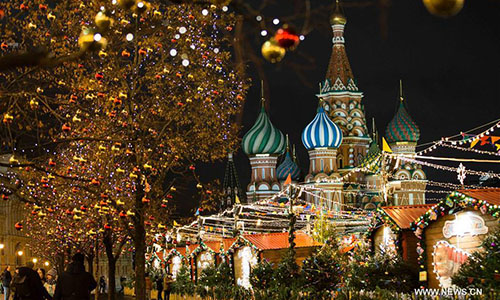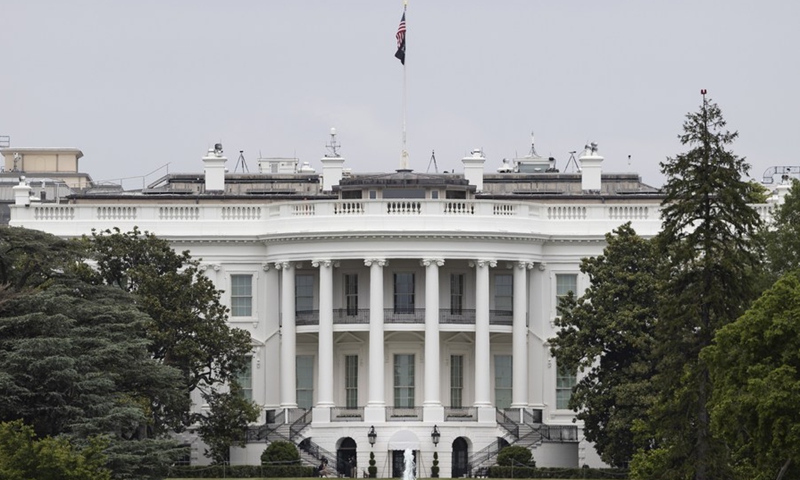New turbulence in US-China-Russia geopolitical triangle
By Victor Larin Source: Global Times Published: 2020/9/13 14:38:20

Lights and decorations for the New Year are seen at the Red Square in Moscow, Russia, on Dec. 26, 2017. (Xinhua/Wu Zhuang)
Since the mid-20th century, the intricacies within the China-Soviet Union/Russia-US strategic triangle are one of the most attractive and intriguing topics for scholars. They are focus of many analytical forecasts and pseudo-scientific speculations, providing visual material for politicians in power.
The whole history of this geopolitical structure involves continuous maneuvers by each side. The countries search for benefits, formulate elements of deterrence, and strike balances. It follows this logic: "Every party plays for itself," or "two against one."
The current configuration of relations in this triangle is not a replica of previous ones. Now we are watching a combination of "one against two" where the US is playing simultaneously against Russia and China. The White House is the initiator in both games. The leaders of Russia and China have repeatedly stressed that their strategic partnership is cooperation with a plus sign; it is not aimed at any third power, including the US, or a bloc of countries.
However, US political elites are furious with the failure of their intentions to change the political systems of Russia and China as well as to tether the two countries as satellites into the world structure that is beneficial to the US and controlled by Washington. So they called Russia and China "strategic competitors" and resorted to various means and methods in order to not only weaken them, but also actively slow down their development. US elites work hard to undermine the countries' economic and social stability, and also embroil them against each other.
Political pressure, economic blackmail and ideological sabotage are widely used to achieve this goal. The fight with China is being waged primarily on the economic and technological fronts. Meanwhile, the struggle against Russia is carried out in the field of global and regional politics. At the same time, Western propaganda actively and aggressively presents Russia and China as the sworn enemies of basic Western (American) values - freedom and democracy. And it works. According to a Pew Research Center poll in March 2020, 62 percent of Americans perceive China as a threat to the US, while roughly 56 percent think the same about Russia.
Hardly any of the US strategists, given the dominant anti-Russian and anti-Chinese sentiments within the US main political parties and public, today are seriously considering the idea of tactical "friendship" with one of Russia and China against the other, as happened successfully for the US in the 1970s. US political elites are internally divided, intolerant of opponents and extremely aggressive. They do not even think about seeking compromises and mutually beneficial solutions. This rich cabal is openly betting on forceful pressure and head-on collisions with any real and potential adversaries, rivals or competitors of the US. All means are good for this. Especially those drawn from the dusty arsenal of Anglo-Saxon diplomacy with its basic principle of "divide and conquer." Therefore, Washington does not even show a minimal desire to shift relations with Moscow or Beijing into a trilateral positive dialogue. Instead it sophisticatedly strives to drive a wedge between Moscow and Beijing, sows seeds of doubt and mistrust, suspicion and enmity between them.

Tiananmen Rostrum Photo: IC
In the middle of the first decade of the 21st century, Washington realized that Moscow did not intend to follow the mainstream of US policy and was determined to fight back in case of an encroachment on Russia's vital interests. At the same time, the Russian-Chinese strategic partnership began to be viewed in Washington as one of the serious challenges to US interests and politics. In the fall of 2006, a conference was held at the US State Department on American-Chinese relations for the years 1969-80. Several key individuals who shaped US Chinese policy at that time attended the event. The keynote speaker Philip D. Zelikow, counselor of the US Department of State, said the following: "We need the Chinese to correct the Russians and to discipline the Russians." Some time later, after Russia set its teeth at the Munich Security Conference (2007) and the North Caucasus (2008), two leading figures of US politics - Henry Kissinger and Zbigniew Brzezinski - launched the sensational notion to divide the world between the US and China, to form something like G2.Generally speaking, it is difficult to imagine that the US would agree to concede at least an inch of its preferable seat on the top of Mt. Olympus, and not to anyone, particularly not an imagined "totalitarian Beijing."
By its very nature, it was a loosely disguised provocation directed against the Kremlin, but this fake worked. Some politicians and experts in Russia took this idea seriously as the intention of the Big Two to divide the world. The contamination of "Chimerica," coined by US scientists a little earlier, also came to the point. Its author Niall Ferguson interpreted his brainchild much more simply as "the partnership between the big saver and the big spender," but the original meaning of the expression was soon forgotten. Despite the fact that China officially refused to even discuss such a deal, the world media, hungry for sensations, swallowed the bait along with the hook, discussing the prospects of building a "US-Chinese universe" in every way.
Parallel to this, Washington began playing the Russian card against China. US academic and journalistic communities were spinning the flywheel of the "yellow threat" in Russia, frightening Russians with the consequences of the "Chinese expansion" in Siberia and the Far East, supporting and fanning the fears and phobias already existing in Russian society. Tens and hundreds of publications on this topic appeared soon in scientific journals, electronic and print media in the US and Europe. This immense propaganda also finds its audience and response in Russia, where the anti-Chinese sentiments fostered during the Soviet-Chinese confrontation were revived in the 1990s and deeply embedded in the minds of some people. According to our estimates, such sentiments are typical for 20-25 percent of people living in Pacific Russia.
Nevertheless, it is obvious that the overwhelming majority of Russians support the development of relations with China. According to the American Pew Research Center, 71 percent of Russians have a favorable view of China. This figure is several times higher than in the US, Australia or Japan. A 2019 poll by the Russian Public Opinion Foundation gave a figure that said 51 percent of Russians consider relations between China and Russia as "the closest and friendliest." Only 1 percent ranked China as an "unfriendly" state.
Almost half of the residents in the Russian territories bordering China (48 percent) are in favor of the priority development of economic ties with China. And only 4 percent of people there assess the prospects for Russian-Chinese relations as "bad." However, negative sentiments do exist, and it is one of the reasons for Chinese apologists of "Chimerica" to talk about the "Russian threat." It expresses doubts about the reliability and prospects of Russia as a partner, and hints about its readiness to come to an agreement with Washington behind China's back.

The White House is seen in Washington D.C., the United States, on May 21, 2020.Photo:Xinhua
Of course, the word "never" is unacceptable in politics. But the conspiracy between Russia and the US against China looks more like a plot from unscientific fiction than a well-founded forecast, at least because neither Russian authorities nor ordinary citizens trust US politicians today. A total of 71 percent of Russians, as shown by the above-mentioned FOM poll, consider the US to be an unfriendly state to Russia. In the same year, a study conducted by the Public Opinion Research Laboratory of the Institute of History of the Far Eastern Branch of the Russian Academy of Sciences (Vladivostok) in the territories of Pacific Russia bordering China showed that 42 percent of their residents view US policy as a threat to Russian interests and only 7 percent see the US as the main economic partner. Such sentiments of the Russians allow us to assume that Washington's attempts to make Russia quarrel with China are doomed to failure. But this state of affairs is not a reason to relax. The US has a wealth of experience in political intrigue, behind-the-scenes games, and will spoil a lot of blood for both Russia and China.Turning to the past, one can recall almost detective-like stories about how the US unwittingly and often deliberately corrected the course of Russian-Chinese relations and always did it exclusively in its own favor and for the sake of its interests. These were US attempts to gain a foothold in Siberia in the mid-19th century, their pushing Japan to go to war against Russia in the early 20th century, and unexpected flirtations with Soviet leaders in the late 1950s as well as with Chinese leaders in the early 1970s. In general, with "our American partners," as Russian President Vladimir Putin calls them, one must always keep an eye open. They are very adept at undercover politics, multi-step secret operations and pitting their real and potential rivals against each other. It seems that there are no experts of Kissinger level in the US political horizon today, but this does not mean that they are not there.
At the same time, trying to analyze and predict the actions of US strategists, one must always keep in mind an important motive, which always latently influences the choice of their priorities. Today it is quite obvious that one of the main reasons for the ongoing US struggle against China is economic competition. His Majesty the Dollar, not the ideas of democracy and freedom, is the engine of US politics. It is curious that with all the various Washington political attacks on Russia, economic sanctions and restrictions that we have observed in the last year and a half, the volume of Russian-American trade in 2019 grew by 4.9 percent, while Russian trade with China increased only by 2.5 percent. In the first half of 2020, the volume of trade between Russia and the US decreased by 5.5 percent, while with China by 5.7, and with South Korea, which does not impose any sanctions against Russia, by 27 percent.
Today, the most unstable side of the China-Russia-US triangle is Washington. The US political system, as the current situation in the country shows, is seriously ill. Under these conditions, Russian political scientists and international experts express the dominant idea that the conflict between the US and China is more an opportunity for Russia than a threat. I am confident that this is a real threat to both Russia and China, since both the White House and Capitol Hill unreasonably but confidently perceive them as the root cause of US' troubles and problems. The US still has enough strength and resources to fight on two fronts - both with Russia and with China, but it is tempting for Washington to engage them in an internal conflict again. The current squabbles within the US political elites should not discourage us. When it comes to US interests, which are based on preserving the world order from which Washington draws resources for its prosperity, internal contradictions are sidelined. Regardless of who will be at the helm of the country following the results of the upcoming elections, it will be naive to expect a change in its foreign policy. And we will still hear many unpleasant words from the Capitol Hill and from the White House both about China and about Russia.
The author is Academician and principal researcher at the Russian Academy of Sciences. opinion@globaltimes.com.cn
Posted in: VIEWPOINT